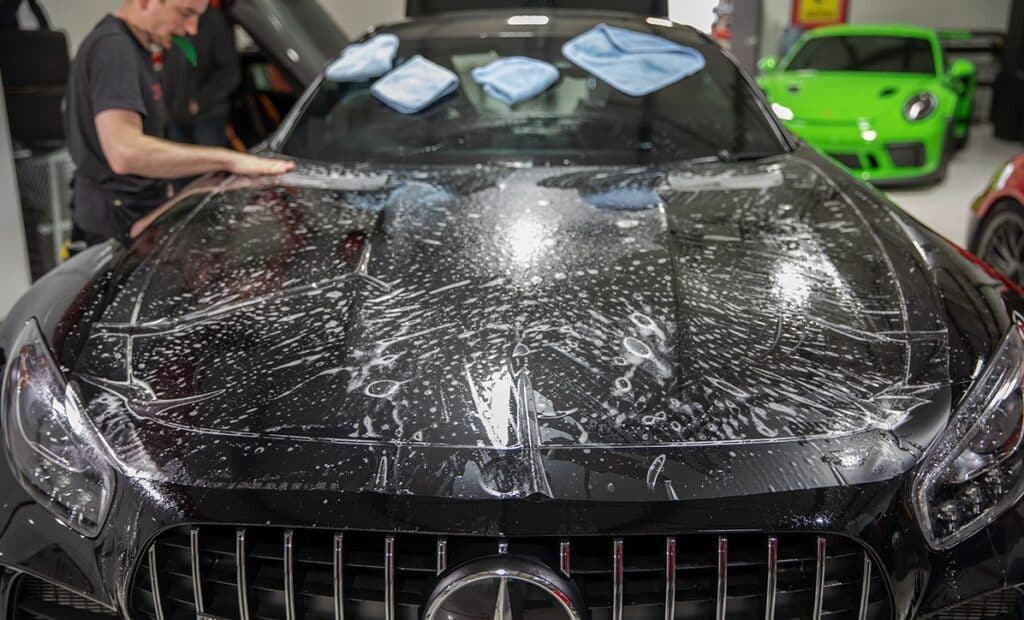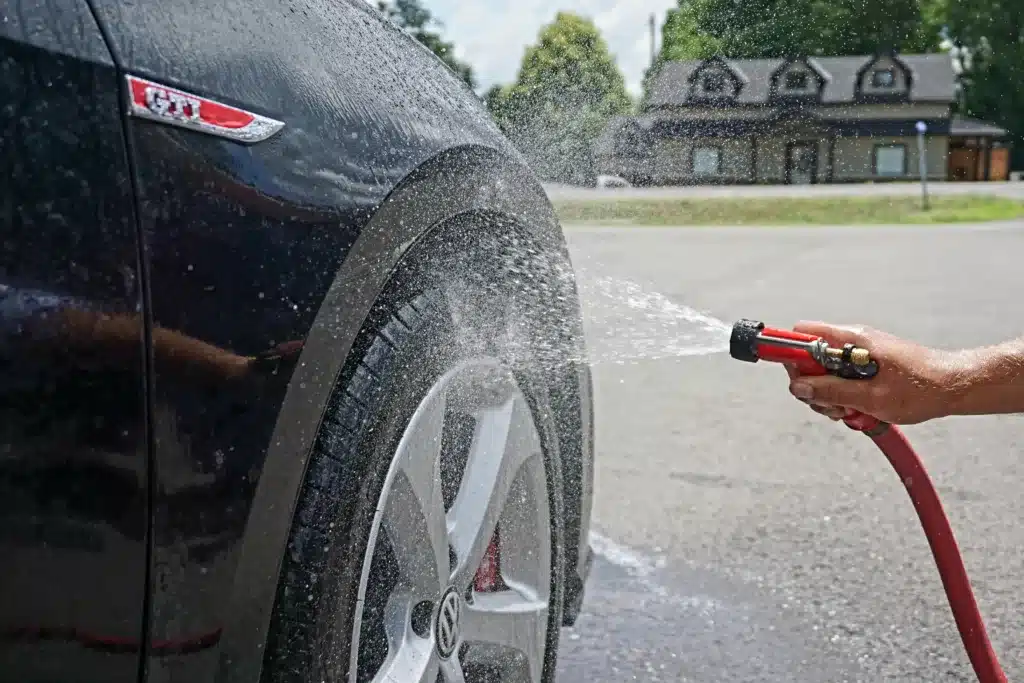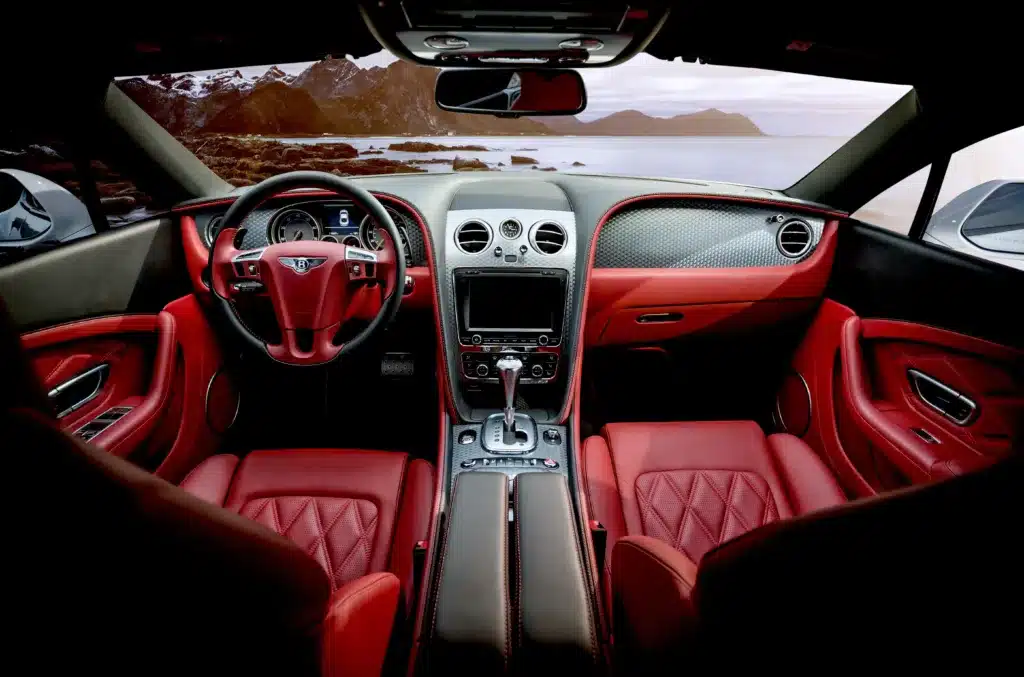
When you purchase a new vehicle, you want it to remain the same forever. You want it to keep looking like it does the day you buy it. In order for that to happen, your vehicle needs some form of protection, something that protects it from the forces of nature that can wreak havoc on a vehicle’s look. You’ve heard about protective films, or something called a “Clear Bra,” but the details are fuzzy. Well, it’s time for a formal introduction: Car Buyer, meet Car-Protection. Here’s what you should know about Automotive Paint Protection Film.
Automotive Paint Protection Film: What Clear Bra does for your car
Automobile protective films are known by many different names: Clear Bra, Clear Mask, Invisible Shield, Clear Wrap, Rock Chip Protection, Car Scratch Protective Film, etc. The most common terms for car protective films are simply Paint Protection Film and Clear Bra, and we’ll use those two terms interchangeably in this article.
The whole point of Automotive Protective Films is to keep your car looking good for longer. Simple as that. A Car Paint Protection Film is the most comprehensive form of defense you can use to protect your car’s appearance from everything that can damage it. For example, if you spend money researching the best way to paint your car, learning how spray booth filtration works and learning what type of paint you should use, and then your car is damaged by a passing branch or scuff – you will not be satisfied. The high impact resistance of Paint Protection Film means it will protect your paint from chips and scratches caused by rocks and road debris. As the urethane film is resistant to corrosion and acidic contaminants, it creates a line of defense against chemicals like bird droppings, bug splatter, or mineral deposits and acid rain. UV rays do not oxidize it and it will protect your paint from fading. A quality film has a top layer made from elastomeric polymers, which return to their original shape after being stretched or disfigured, giving it a “self-healing” property. Thus, if a film receives light scratches, it absorbs the damage and returns to the texture and properties it had before.
Having said that, applying a quality Clear Bra to your car today can help maintain its look and quality for years to come.
It is important to remember, however, that Paint Protection Film isn’t a cure-all to keep shiny cars shiny, even though its benefits are numerous. Your car will never be bulletproof. Even Clear Bras can be punctured by rocks. Long-term bird droppings and bug splatters can damage film. You will still need to wash your car after applying Paint Protection Film. To achieve perfect and unending gloss, there is no one-stop-shop. That is not what Paint Protection Film can offer. Instead, Paint Protection Film promises that when the forces of nature attack your car’s paint, the paint will fight back. In addition to adding value to your car, you will protect it from damage you could not avoid otherwise. In other words, Paint Protection Film makes your car look better longer.
The history behind Clear Bra
It’s helpful to get some background information when getting to know someone or something. So let’s take a look at the technology behind Clear Bra.
Typically, automotive paint protection films are made of urethane and are transparent. The urethane technology was developed during the Vietnam War, when U.S. helicopters crashed because of damage to their rotor blades. The U.S. military collaborated with 3M to develop a technology that is lightweight, yet resilient, and can be replaced for a fraction of the cost of replacing an entire rotor blade (or a crashed helicopter). Due to the success and efficiency of urethane films, the military expanded their use of them to the noses of fighter jets in the 1970s, and to this day, 3M still produces urethane films for military and aerospace applications. Today, aerospace materials are leaning toward solvay process materials to help with design and sustainability, but some older materials are still being used due to their success, such as urethane films.
NASCAR recognized that urethane technology could be useful for protecting race cars’ front halves in the 1980s. Advertising companies spend a lot of money to get their decals plastered on the front of fast cars, and I’m sure they weren’t too happy about rock chips splattering on their decals.
During the 1990s, urethane films became available to the general public for automotive protection. Since then, the technology has been continuously refined and improved, and has been warmly received by the automotive industry. Paint Protection Films are now OEM approved by virtually all automakers.
What is used to make Paint Protection Film?
Whenever you wrap something around a fine new car, you’ll want to know not only where it came from, but what it is as well. Let’s take a look inside a sheet of Paint Protection Film. Urethane, a versatile and powerful polymer made of carbamate links, is the key ingredient. In addition to being lightweight and transparent, it has unique properties as a compound. However, unlike plastic, it does not crack or break easily. It is highly resistant to impact, abrasion, and corrosion. The material is also extremely flexible, and it can regain its natural shape after being stretched or disfigured.

There is no shortage of uses for urethane as a polymer, but today we are discussing your car, and urethane serves as the central ingredient in a clear film around 8 mils (0.008 inches) thick.
A quality Paint Protection Film has at least two other layers in addition to the central urethane (or polyurethane) layer. To begin, the top is lined with an elastomeric polymer-based clear coat. As we already mentioned, this is the part of the film that enables it to self-heal from small scratches. But it does much more than that. In a good film, the clear coat will have a low surface energy, which prevents organic compounds, like bugs or bird droppings, from bonding to the film.
Additionally, the bottom is lined with an acrylic adhesive that is designed to be flexible, so that you can wrap it around any shape of your vehicle; durable, so that the film will not break over time; and invisible, so that it will not affect the paint.
Are there any liabilities? What about yellowing, blistering, or peeling?
A properly applied Paint Protection Film is invisible to the naked eye and does not compromise the depth and clarity of your factory paint. What about over time? If you’ve read around the Internet, you may have encountered individuals reporting that their Clear Bras developed defects over time. Some people who have purchased an aftermarket Clear Bra have experienced yellowing, blistering, and peeling. To make an informed decision, it’s important to know what’s behind each of these generations and what you can do to avoid them.
Yellowing
Paint Protection Film has been criticized for turning yellow over time, which, of course, has a major impact on the look of a vehicle, especially white ones. As soon as Clear Bras were introduced to consumer automobiles, this complaint was particularly prevalent. Research revealed that the yellowing effect was caused by the adhesive that was used to bind the film to the car body. UV exposure caused the adhesive to oxidize, causing discoloration. Due to this discovery, companies began researching alternative adhesives, and began using the acrylic adhesives found on most Clear Bras today. Newly developed adhesives are UV resistant and will not oxidize or discolor. This effectively eliminated discoloration concerns for Paint Protection Film. When you put a sub-standard film on your car today, it may use an inferior adhesive and result in discoloration. Quality professional film manufacturers, like XPEL and LLumar, use an adhesive that does not discolor when exposed to UV light.
Blistering
When air bubbles are found beneath the film of a Clear Bra, the bra is said to “blister”. It has everything to do with the quality of application. A bubble of air occurs when a contaminant is trapped under the film, causing separation between the vehicle body and the Clear Bra. Over time, this can cause bubbles to grow under the film. The application process includes paying attention to the vehicle’s surface before any film touches it. This includes washing, claying, and polishing. Additionally, in a professional application center, the air is filtered to remove contaminants that may get trapped underneath the film. As a result, a subpar film and unprofessional application can result in blistering. The risk is very minimal when a quality film is properly applied by an experienced technician.
Peeling
Peeling occurs when the edges of a film begin to separate from the paint. This can be caused by a substandard film or unprofessional application, but improper care is often the cause. As such, if you are using a pressure washer to clean a car with Paint Protection Film, it is important to stay at least 12 inches away from the film, and particularly from any exposed edges. By directing a pressure washer at the edge of a Clear Bra, the film can begin to lift, leading to peeling.
In summary, complaints against Paint Protection Film are based on real-life situations. As we have outlined, however, these situations have specific causes that can be avoided. The risk of defects such as yellowing, blistering, or peeling is very low if you purchase a high-quality film (such as XPEL Ultimate or LLumar Platinum Paint Protection Film) from companies like Unique Auto Concepts, have it professionally installed, and properly care for your protected vehicle. If any of those things should happen, you may be covered by a ten-year manufacturer’s warranty.




